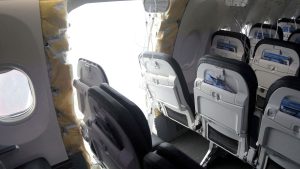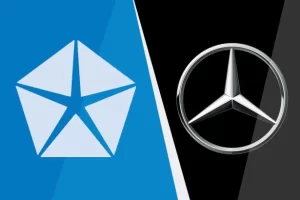![]() In 1997 Boeing and McDonnell Douglas agreed on a merger. That marriage looked great on paper… Boeing’s strength was McDonald Douglas’ weakness. And vice-versa. A match made in heaven, or at least in the clouds. But the Boeing deal demonstrates how brands and corporate mergers usually butt heads.
In 1997 Boeing and McDonnell Douglas agreed on a merger. That marriage looked great on paper… Boeing’s strength was McDonald Douglas’ weakness. And vice-versa. A match made in heaven, or at least in the clouds. But the Boeing deal demonstrates how brands and corporate mergers usually butt heads.
Boeing’s shortcomings on the military side would be bolstered dramatically by partnering with McDonald Douglas, maker of the F15 Fighter, the Apache helicopter, the Tomahawk missile, and many other successful weapons systems.
McDonald Douglas’ standing in the commercial airline business would be raised by teaming with Boeing, the long-time king of the skies.
Two global brands, both looking to shore-up the weakest parts of their business. Two diametrically opposed corporate cultures. Two distinct brands and one ill-fated corporate merger.

The McDonald Douglas brand revolved around blowing things up. Inflicting damage. Efficiently killing the enemy. Protecting democracy.
Their preferred customers were military men around the world, all cut from the same, heavily starched cloth. And when you sell to the same, homogeneous group of bureaucrats for a long time, you begin to look and act a lot like your customers.
At Boeing the culture revolved around two words: Safety and efficiency. The imperative in Boing’s Seattle headquarters was just the opposite of McDonald Douglass… kill no one. Get people safely and comfortably to their destination and, of course, help the airlines make a lot of money.
Boeing’s customers were airline industry execs, not DOD officials or foreign generals. B-to-B sales are a lot different than government contracts.
The two cultures were sure to clash. And as Peter Drucker famously said, “culture eats strategy for breakfast.”


For some first-hand insight I spoke with a retired Boeing executive who was directly involved with that merger and the integration of the two giant companies.
“There’s always going to be one executive who ends up taking the pivotal lead in the new, merged company. And that person came from McDonald. So he was naturally more inclined toward the military side of things. It’s like having two kids you don’t give equal attention to… Eventually they start fighting. Then if you take the allowance from one of them, you got some real problems. Eventually, both kids will suffer,” the exec told me.
There were the usual leadership problems, plus profound problems at lower levels where manufacturing integration was supposed to occur.
“Integration starts at the bottom. It’s like zipping up a jacket… You can make progress to a point, but the higher you go, the harder it is to bring the two sides together,” the Boeing exec said. “Literally, we couldn’t find any common ground.”
So if you have two competing corporate cultures merged in one company, what does that mean for the brands?
In this case, the McDonell Douglas brand faded away. It’s now called Boeing Integrated Defense Systems.
On the commercial side, the Boeing brand has taken a missile hit. The 737 Max3 software disaster plus a long string of quality control issues including a blown-out door have killed the company’s credibility and allowed AirBus to capture the #1 share of market.
Some would argue that the long delays on the 787 Dreamliner and even the Max 3 disaster could easily be traced back to the lack of manufacturing integration since the merger.
I also know people who work at Boeing in the Seattle area who say morale is at an all time low. The NTSB’s preliminary report called it “extremely bad manufacturing technique.”
“In military aviation they can push the technology and take more risks. In the commercial airline business, you don’t use unproven technology because the risks are just too great,” my source said.
“But with the new leadership, there was a lot of pressure to try new things at Boeing. The 787 Dreamliner is a fantastic platform, but they chose an unproven design for the wing-to-body joints, and they had to go back and fix it. It was enormously expensive.”
The rash of bad publicity is tremendously painful for a brand that has, historically, stayed successfully under the radar.
Because in the commercial airline business, front page news is always bad news.

The business world is littered with similarly conflicted cases where brands and corporate mergers were at odds.
For instance, the Chrysler/Dalmer Benz merger was doomed from the start. (At least they didn’t try to put the Mercedes nameplate on all the Chrysler minivans.) Now it’s Fiat/Chrysler, and the Chrysler brand is in big trouble.
The McDonald Douglas-Boeing corporate merger was like Mercedes merging with the maker of the Abrams tank.
Not exactly compatible corporate missions.
I seriously doubt that very many big-league M & A attorneys are sitting around their big, mahogany conference tables contemplating the nuances of the brands they’re trying to bring together. They don’t account for cultural synergy or shared brand values. Often it’s more about eliminating competition, covering up corporate inefficiencies or pleasing wall street.
With branding and corporate mergers, it’s almost always a numbers game, not a branding play.
If brands were a consideration, a lot more merged companies would maintain two different brands — rather than trying to integrate under one corporate banner.
McDonnell Douglas would still be the brand for military applications and Boeing would be the brand for all commercial operations. Two brands operating independently under one corporate umbrella.
Amazon’s acquisition of Zappos is a more successful example. The two companies have similar, long-term visions. They both emphasize customer service and loyalty. And they’re both on-line retailers.
Not only that, Bezos is smart enough recognize the value of the Zappos brand, and has not killed it.
If you’re seriously considering a merger or an acquisition, include a thorough brand evaluation in your due diligence.
Study the corporate cultures. Talk to the CMOs about a long-term brand strategy for the new, combined brand. Consider the intangible value of each existing brand.
Brands and corporate mergers almost always clash. And if integration of the two brands under one is the plan, it might be a lot harder than you think.
Just ask the engineers at Boeing.
Learn more about brand value and what all the truly great brands have in common.


I’m really loving your posts, please keep them comming, Thank You.
Great Post! I love to read articles that are informative and beneficial in nature. Thank You for sharing your knowledge.